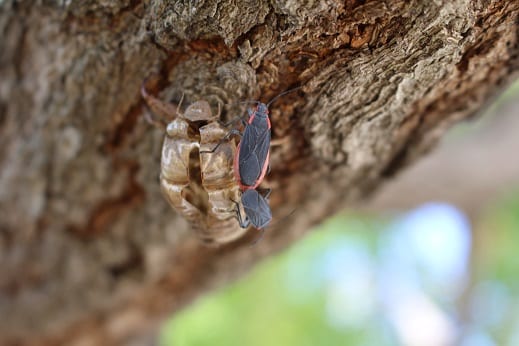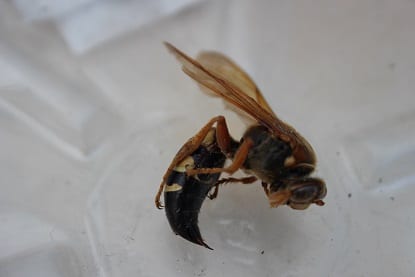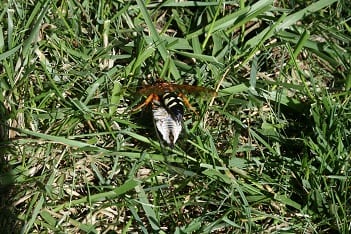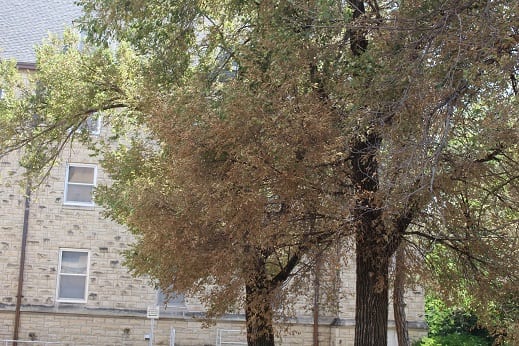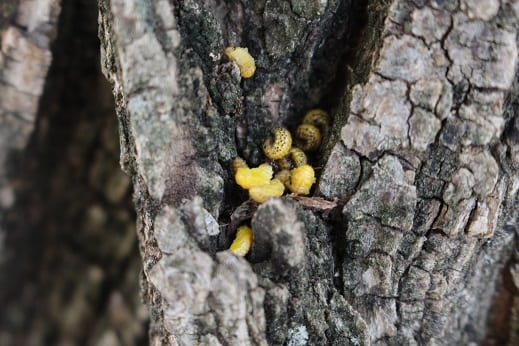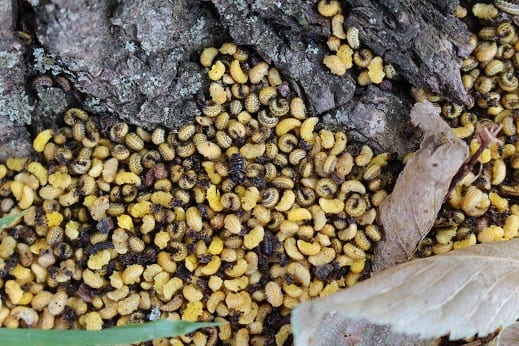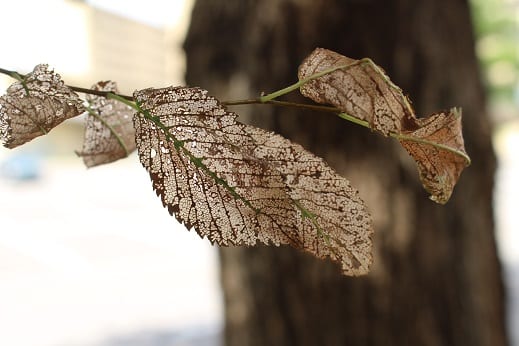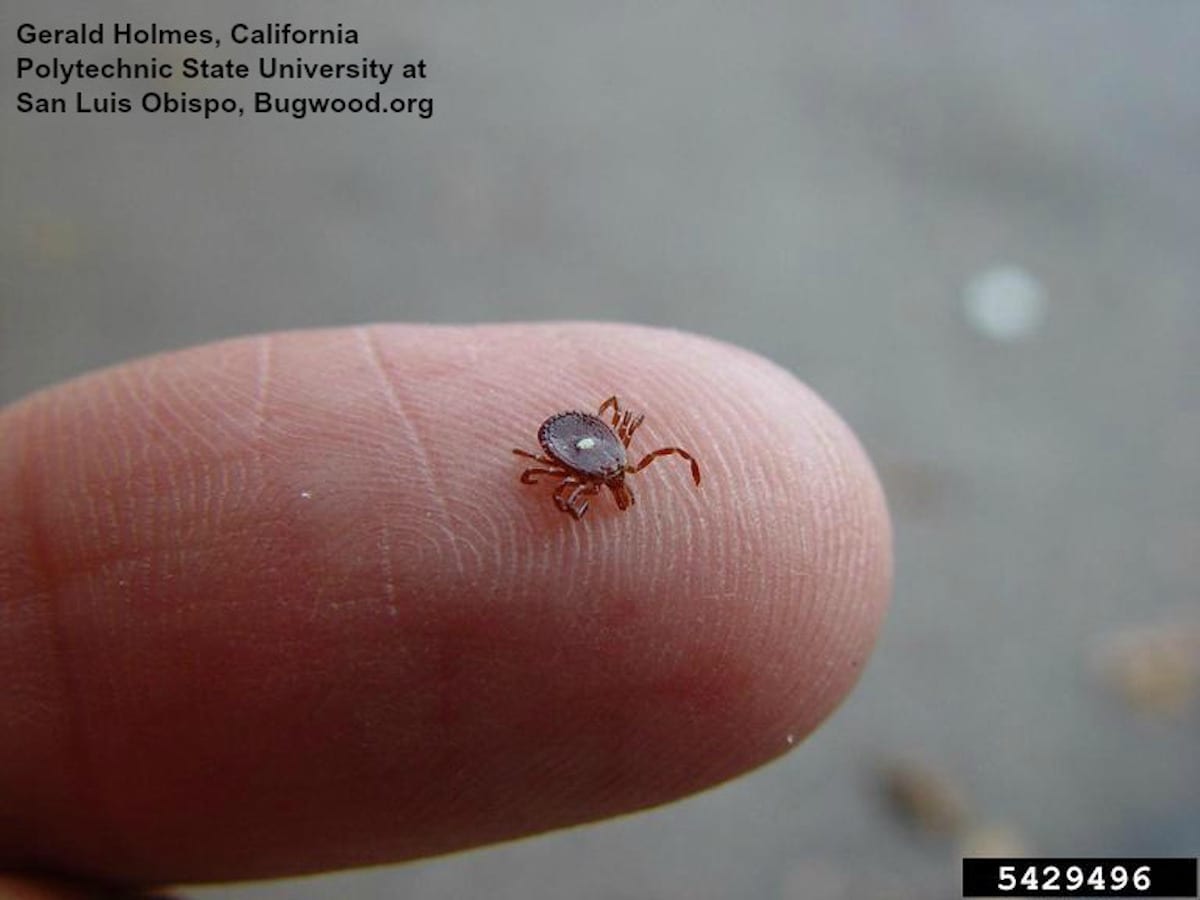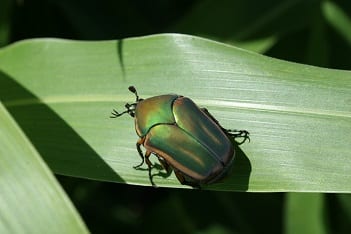–by Dr. Raymond Cloyd
Japanese beetle, Popilla japonica, adults are out in full-force in most regions of Kansas feeding on different plant species, including: roses, Rosa spp.; littleleaf linden, Tilia cordata; and Virginia creeper, Parthenocissus quinquefolia, among many other plant species. The means of dealing with the adult stage of Japanese beetle are limited, and have been for many years, with the use of insecticides still being the primary strategy. Japanese beetle adults are one of the most destructive insect pests of horticultural plants in both landscapes and gardens. In addition, the larva or grub is a major turfgrass insect pest in home lawns, commercial settings, and golf courses.
Japanese beetle adults are 9/16 of an inch in length and metallic green with coppery-brown wing covers (Figure 1).
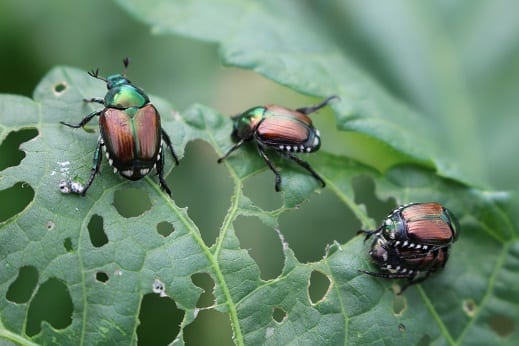
Fig 1. Japanese beetle adults feeding and mating on a leaf (Author–Raymond Cloyd, KSU
There are about 14 tufts of white hair present along the edge of the abdomen (Figure 2).
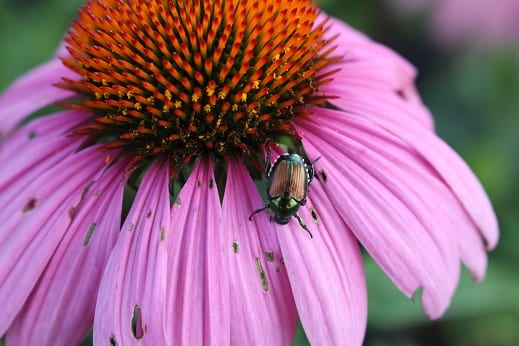
Fig 2. Japanese beetle adult feeding. Note white tufts of hair along the edge of the abdomen (Author–Raymond Cloyd, KSU).
Adult Japanese beetles emerge from the soil and live up to 45 days feeding on plants over a four-to-six-week period. Adults feed on many ornamental plants including: trees, shrubs, vines, herbaceous annual and perennials, and of course—roses. Plant placement in the landscape and volatiles emitted by plants are factors that affect adult acceptance. Furthermore, Japanese beetle adults produce aggregation pheromones that attract both males and females to the same feeding location. Adults can fly up to five miles to locate a host plant; however, they tend to only fly short distances to feed and for females to lay eggs.
Japanese beetle adults feed through the upper leaf surface (epidermis) and leaf center (mesophyll), leaving the lower epidermis intact. Adults avoid feeding on tissue between leaf veins, resulting in leaves appearing lace-like or skeletonized (Figure 3).

Fig 3. Japanese beetle adult feeding damage on leaf (Author–Raymond Cloyd, KSU)
They are most active during warm days, feeding on plants exposed to full sun throughout the day, which is likely why roses are a susceptible host plant because roses require at least six hours of direct sunlight in order to flower. Japanese beetle adults start feeding at the top of plants, migrating downward after depleting food sources. Japanese beetle adults will also feed on flowers (Figure 4),
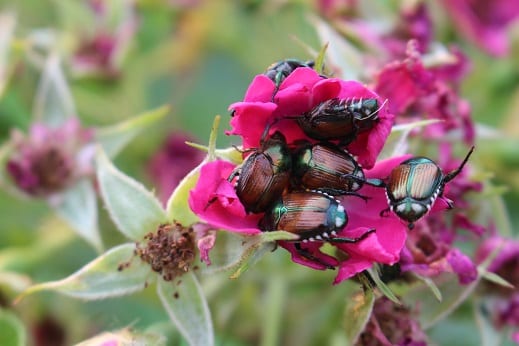
Fig 4. Japanese beetle adults feeding on rose flower (Author–Raymond Cloyd, KSU)
chewing holes in flower buds, which prevents flowers from opening or causes petals to fall prematurely.
Dealing with Japanese beetle adults involves implementing a variety of plant protection strategies, including: cultural, physical, and insecticidal controls. Cultural control is affiliated with maintaining healthy plants through proper irrigation, fertility, mulching, and pruning, which are important in minimizing ‘stress’, which may possibly decrease susceptibility. Moreover, removing weeds that are attractive to Japanese beetle adults such as smartweed (Polygonum spp.) may alleviate infestations. Physical control involves hand-picking or collecting Japanese beetle adults from plants before populations are extensive. The best time to hand-pick or collect adults is in the morning when ambient air temperatures are typically ‘cooler.’ Adults are easily collected by placing a wide-mouthed jar or bucket containing rubbing alcohol (70% isopropyl alcohol) or soapy water underneath each adult, and then touching them. Adults that are disturbed fold their legs perpendicular to the body, and fall into the liquid and are subsequently killed. This procedure, when conducted daily or every-other-day, particularly after adults emerge, may substantially reduce plant damage. The use of Japanese beetle traps (Figure 5)
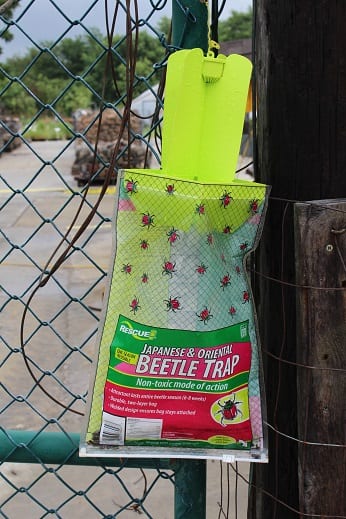
Fig 5. Japanese beetle trap (Author–Raymond Cloyd, KSU)
within a landscape or garden is not recommended since the floral lure and synthetically-derived sex pheromone may attract more adults into an area than would ‘normally’ occur. Japanese beetle adults may also feed on plants before reaching the traps, which increases potential damage.
Spray applications of contact insecticides will kill Japanese beetle adults. However, repeat applications are required; especially when populations are excessive. The insecticide carbaryl (Sevin®) and several pyrethroid-based insecticides; such as those containing bifenthrin or cyfluthrin as the active ingredient, will suppress Japanese beetle adult populations. However, most of these insecticides will also directly harm many natural enemies (parasitoids and predators). Continual use will result in secondary pest outbreaks of other pests including the twospotted spider mite, Tetranychus urticae. In addition, these insecticides are directly harmful to honey bees and bumble bees. Therefore, applications should be conducted in the early morning or late evening when bees are less active. In general, systemic insecticides are not effective against Japanese beetle adults because they have to feed on leaves and consume lethal concentrations of the active ingredient. If extensive populations are present, plant damage can still occur.
The battle against Japanese beetle adults requires patience, persistence, and diligence to prevent adults from causing substantial damage to plants in landscapes and gardens.

